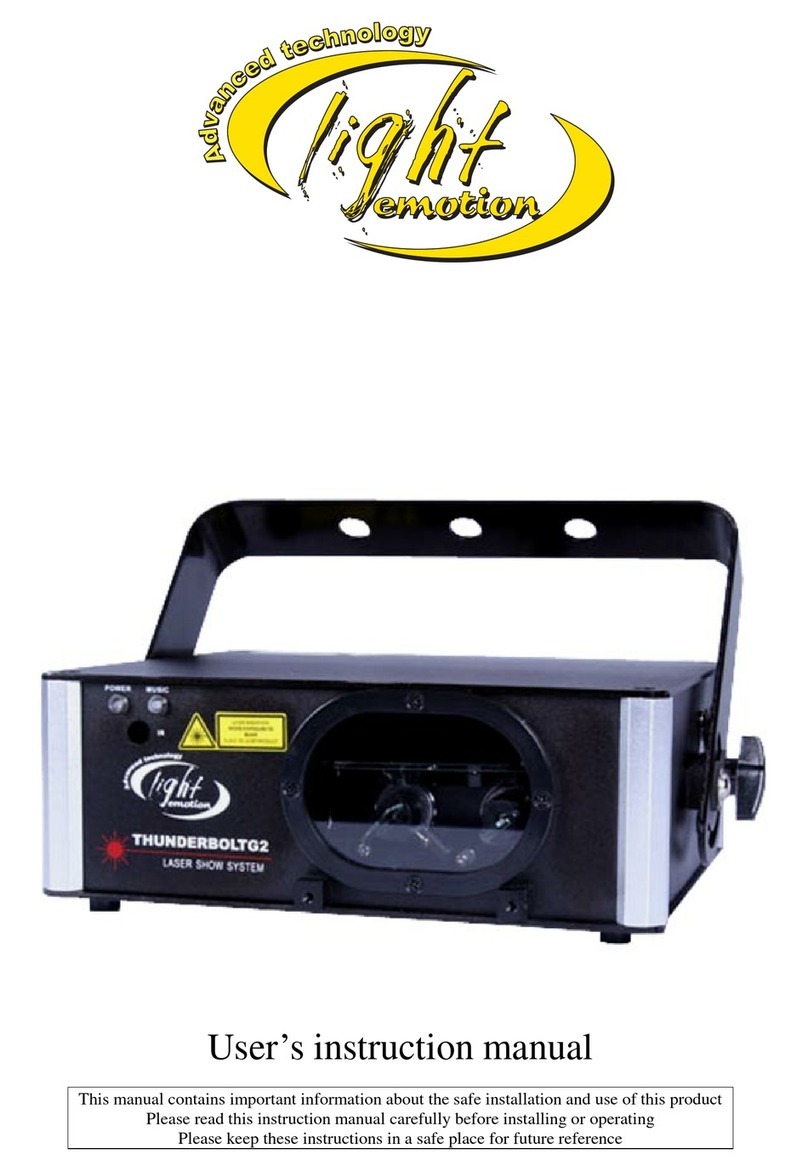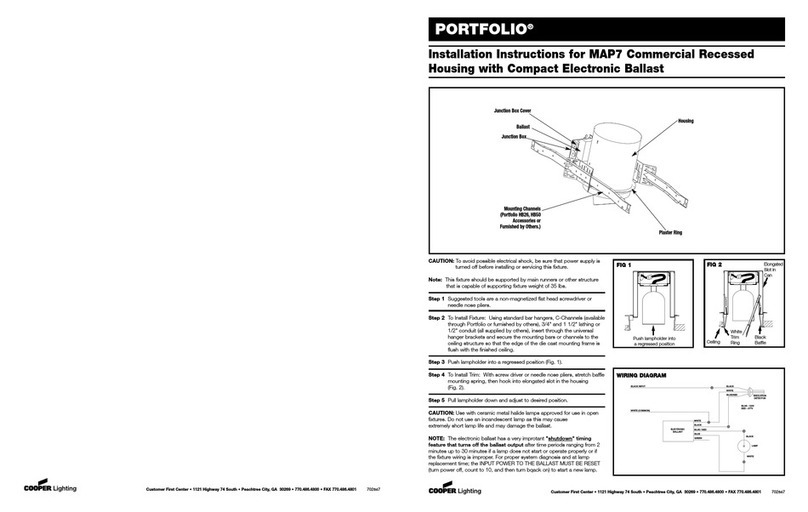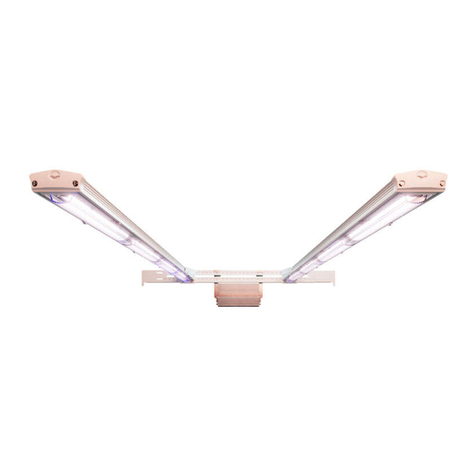HEICO lighting Polyoptik Service manual

1/25
PolyoptikTM
400, du Parc, Saint-Eustache, Québec Canada, J7R 0A1
Tel: +1.450.491.5671 +1.800.665.1166
Fax: +1.450.491.3788 www.heicolighting.com
Technical Bulletin #34
PolyoptikTM Architectural Lighting Applications Installation Guide
Table of Content
Loading and Photometric Information Summary……………………………………………………………………………………………………2
Loading……………………………………………………………………………………………………………………………… 3
Refer to the wiring configuration that suits your project
Twisted Pair Extension……………………………………………………………………………………………………………………………………3
BX Extension…………………………………………………………………………………………………………………………………………………. 5
Straight Pair Extension…………………………………………………………………………………………………………………………………. 7
Single Wire Loop…………………………………………………………………………………………………………………………………………….9
Single Wire Loop with Return………………………………………………………………………………………………………………………11
Twisted Pair with Single Wire Loop………………………………………………………………………………………………………………13
Twisted Pair with Single Wire Loop With Return…………………………………………………………………………………………15
Installation……………………………………………………………………………………………………………………… 20
Installation Instructions……………………………………………………………………………………………………………………………….20
PolyoptikTM Beam Orientation………………………………………………………………………………………………………………………21
Location Definitions……………………………………………………………………………………………………………………………………. 21
Power Supply Electrical Connection in Dry or Damp Locations……………………………………………………………………22
Power Supply Electrical Connection in Wet Locations…………………………………………………………………………………23
On-Site Installation………………………………………………………………………………………………………………………………………24
Warnings………………………………………………………………………………………………………………………………………………………………… 25
Contact us……………………………………………………………………………………………………………………………………………………………….25

HEICO lightingTM Contactless LED System PolyoptikTM Architectural Lighting Applications Installation Guide
Specifications are subject to change without notice. (Technical bulletin #34)
© HEICO lightingTM 2013 –All rights reserved. Made in Canada. 2/25
LOADING AND PHOTOMETRIC INFORMATION SUMMARY
PolyoptikTM LED Modules System Loading
Model
Consumption
Maximum number of modules
Watts per module
LMPS-350/LMPS-DC350
LMPS-750
PolyoptikTM 20˚x20˚
1.35
26
55
PolyoptikTM 40˚x40˚
PolyoptikTM 20˚x40˚
PolyoptikTM 180˚x180˚
PolyoptikTM Photometric Information **
Model
Lens beam
angle
Lumens per
module
Lumens per foot*
Lumens per watt
CRI
White
3000K
White
3500K
White
3000K
White
3500K
White 3000K, 3500K
White 3000K, 3500K
PolyoptikTM 20˚x20˚
20
104
113
416
452
84
82
PolyoptikTM 40˚x40˚
40
98
103
392
412
79
82
PolyoptikTM 20˚x40˚
20 x 40
114
124
456
496
92
82
PolyoptikTM 180˚x180˚
180
98
106
392
424
79
82
* All values are for the maximum allowable number of modules per foot
** Photometric data is subject to change, LM-79 data and IES files are available for 3500K modules.

HEICO lightingTM Contactless LED System PolyoptikTM Architectural Lighting Applications Installation Guide
Specifications are subject to change without notice. (Technical bulletin #34)
© HEICO lightingTM 2013 –All rights reserved. Made in Canada. 3/25
TWISTED PAIR EXTENSION
Calculating the wattage of the LEDs to be installed
The following method can also be used to calculate the load on only one power supply or individual sections of the
architectural lighting project. Please note that the “watts per module" value must be taken from the specification sheet of
the appropriate product.
wattage = number of modules X watts per module
total wattage = wattage of module type 1 + wattage of module type 2 + (…)
Applying the distance factor if applicable
If the power supply is installed away from the LEDs, use table 1 below to apply the appropriate distance factor to the
wattage of the power supply.
Table 1: Distance Factor for Twisted Pair Extension
The distance refers to the distance between the power supply and the first LED module.
Watts available for LEDs = wattage of the power supply X distance factor
The values given in table 1 are usually enough to do proper distance factor calculations. If the distance between the power
supply and the first LED module falls between two columns in table 1, it is possible to calculate the distance factor using
linear interpolation.
Target distance factor =
(target distance –length 1) (distance factor 2 –distance factor 1)
+ distance factor 1
(length 2 –length 1)
Example (target distance of 88 feet with LMPS-750)
Target Distance factor =
(88 –75) (0.69 –0.73)
+ 0.73 = 0.71
(100 –75)
Configuration
Power supply
Feet
0
15
25
50
75
100
125
150
14 AWG
Twisted pair
extension
(figure 1)
LMPS-350
1
1
1
0.95
0.91
0.66
0.41
N/A
LMPS-DC350
1
1
0.95
0.86
0.74
0.62
0.45
N/A
LMPS-750
1
0.85
0.81
0.77
0.73
0.69
0.57
0.50
Figure 1 : Twisted pair extension
Modules are at the end of an extension.
The electrical conductor is a twisted pair type (example CL3P)
This configuration has the best transport performance signal.

HEICO lightingTM Contactless LED System PolyoptikTM Architectural Lighting Applications Installation Guide
Specifications are subject to change without notice. (Technical bulletin #34)
© HEICO lightingTM 2013 –All rights reserved. Made in Canada. 4/25
Calculating the number of power supplies your project requires
When using a distance factor use the “watts available for the LEDs” instead of the “wattage of the power supply”. Round
the result up to the next integer.
Number of power supplies = total wattage / wattage of the power supply
Please note that HEICO lightingTM’s LMPS-350 and LMPS-DC350 have a wattage of 35 watts and the LMPS-750 has a wattage of 75 watts.
Calculating the system wattage
Take the number of watts of LEDs at the output of each power supply and use the appropriate power curve on figure 8 (p.17)
to determine each power supply’s consumption. The average output power can also be used if the load is distributed evenly
throughout the power supplies.
Calculating the total system power consumption
The total system power consumption equals the sum of the power consumption of each power supply.
Calculating the cost of electricity for a year for the complete architectural lighting system
Price of electricity per year =
Total system wattage X hours of usage per day X 365 days per year X price of electricity per kW/h
1000
Please note that “Price of electricity per kW/h” is according to your local electricity rate.
Determining the system efficiency
Due to the high frequency nature of the output of the LMPS power supplies, the input power factor must be used to determine
the system efficiency. Take the input watts of each power supply and use the appropriate power factor curve on figure 9
(p.18) to determine the system efficiency.
Additional Considerations
Distribute the load equally between multiple power supplies. This ensures a uniform level of light across the power
supplies.
Contact HEICO lightingTM for more details about power consumption calculations when using a distance factor.
All calculations are theoretical. Measurements made on the real life installations can differ from the calculations.
EXAMPLE
Modules : 95 PolyoptikTM 20˚X20˚ 3000K & 20 PolyoptikTM 180˚X180˚ 3500K
Power supply : LMPS-750 (75W)
Twisted pair extension : 50 ft
Distance factor at 50 ft: 0.77
Wattage 1 =
95 PolyoptikTM 20˚X20˚ 3000K X 1.35 watts
= 128.25 watts
Wattage 2 =
20 PolyoptikTM 180˚X180˚ 3500K X 1.35 watts
= 27 watts
Total wattage =
128.25 watts + 27 watts
= 155.25 watts
Watts available for LEDs = 75 watts X 0.77 = 57.75 watts/power supply
Number of power supplies required = 155.25 watts total/57.75 watts/power supply = 3 LMPS-750
Therefore, to distribute the load equally, install 38 modules on each of the first 2 power supplies and install
39 modules on the third power supply for the total 115 modules.
Total system power consumption = 63 watts + 63 watts + 65 watts = 191 watts

HEICO lightingTM Contactless LED System PolyoptikTM Architectural Lighting Applications Installation Guide
Specifications are subject to change without notice. (Technical bulletin #34)
© HEICO lightingTM 2013 –All rights reserved. Made in Canada. 5/25
BX EXTENSION
Calculating the wattage of the LEDs to be installed
The following method can also be used to calculate the load on only one power supply or individual sections of the
architectural lighting project. Please note that the “watts per module" value must be taken from the specification sheet of
the appropriate product.
wattage = number of modules X watts per module
total wattage = wattage of module type 1 + wattage of module type 2 + (…)
Applying the distance factor if applicable
If the power supply is installed away from the LEDs, use table 2 below to apply the appropriate distance factor to the
wattage of the power supply.
Table 2: Distance Factor for BX Extension
The distance refers to the distance between the power supply and the first LED module.
Watts available for LEDs = wattage of the power supply X distance factor
The values given in table 2 are usually enough to do proper distance factor calculations. If the distance between the power
supply and the first LED module falls between two columns in table 2, it is possible to calculate the distance factor using
linear interpolation.
Target distance factor =
(target distance –length 1) (distance factor 2 –distance factor 1)
+ distance factor 1
(length 2 –length 1)
Example (target distance of 88 feet with LMPS-750)
Target Distance factor =
(88 –75) (0.63 –0.69)
+ 0.69 = 0.66
(100 –75)
Configuration
Power supply
Feet
0
15
25
50
75
100
125
150
14 AWG BX
(figure 2)
LMPS-350
1
1
.95
.86
.62
.45
N/A
N/A
LMPS-DC350
1
1
.95
.82
.66
.49
.24
N/A
LMPS-750
1
.84
.79
.73
.69
.63
.52
.36
Figure 2 : BX extension
Modules are at the end of an extension.
This configuration is very practical as it enables use of easily
available armoured BX wire. It can also be used on retrofit
installations where BX wire is already installed.

HEICO lightingTM Contactless LED System PolyoptikTM Architectural Lighting Applications Installation Guide
Specifications are subject to change without notice. (Technical bulletin #34)
© HEICO lightingTM 2013 –All rights reserved. Made in Canada. 6/25
Calculating the number of power supplies your project requires
When using a distance factor use the “watts available for the LEDs” instead of the “wattage of the power supply”. Round
the result up to the next integer.
Number of power supplies = total wattage / wattage of the power supply
Please note that HEICO lightingTM’s LMPS-350 and LMPS-DC350 have a wattage of 35 watts and the LMPS-750 has a wattage of 75 watts.
Calculating the system wattage
Take the number of watts of LEDs at the output of each power supply and use the appropriate power curve on figure 8 (p.17)
to determine each power supply’s consumption. The average output power can also be used if the load is distributed evenly
throughout the power supplies.
Calculating the total system power consumption
The total system power consumption equals the sum of the power consumption of each power supply.
Calculating the cost of electricity for a year for the complete architectural lighting project
Price of electricity per year =
Total system wattage X hours of usage per day X 365 days per year X price of electricity per kW/h
1000
Please note that “Price of electricity per kW/h” is according to your local electricity rate.
Determining the system efficiency
Due to the high frequency nature of the output of the LMPS power supplies, the input power factor must be used to determine
the system efficiency. Take the input watts of each power supply and use the appropriate power factor curve on figure 9
(p.18) to determine the system efficiency.
Additional Considerations
Distribute the load equally between multiple power supplies. This ensures a uniform level of light across the power
supplies.
Contact HEICO lightingTM for more details about power consumption calculations when using a distance factor.
All calculations are theoretical. Measurements made on the real life installations can differ from the calculations.
EXAMPLE
Modules : 95 PolyoptikTM 20˚X20˚ 3000K & 20 PolyoptikTM 180˚X180˚ 3500K
Power supply : LMPS-750 (75W)
BX extension : 50 ft
Distance factor at 50 ft: 0.73
Wattage 1 =
95 PolyoptikTM 20˚X20˚ 3000K X 1.35 watts
= 128.25 watts
Wattage 2 =
20 PolyoptikTM 180˚X180˚ 3500K X 1.35 watts
= 27 watts
Total wattage =
128.25 watts + 27 watts
= 155.25 watts
Watts available for LEDs = 75 watts X 0.73 = 54.75 watts/power supply
Number of power supplies required = 155.25 watts total/54.75 watts/power supply = 3 LMPS-750
Therefore, to distribute the load equally, install 38 modules on each of the first 2 power supplies and install
39 modules on the third power supply for the total 115 modules.
Total system power consumption = 63 watts + 63 watts + 65 watts = 191 watts

HEICO lightingTM Contactless LED System PolyoptikTM Architectural Lighting Applications Installation Guide
Specifications are subject to change without notice. (Technical bulletin #34)
© HEICO lightingTM 2013 –All rights reserved. Made in Canada. 7/25
STRAIGHT PAIR EXTENSION
Calculating the wattage of the LEDs to be installed
The following method can also be used to calculate the load on only one power supply or individual sections of the
architectural lighting project. Please note that the “watts per module" value must be taken from the specification sheet of
the appropriate product.
wattage = number of modules X watts per module
total wattage = wattage of module type 1 + wattage of module type 2 + (…)
Applying the distance factor if applicable
If the power supply is installed away from the LEDs, use table 3 below to apply the appropriate distance factor to the
wattage of the power supply.
Table 3: Distance Factor for Straight Pair Extension
Configuration
Power supply
Feet
0
15
25
50
75
100
125
150
14 AWG straight
pair extension
(figure 3)
LMPS-350
1
1
1
.95
.74
.41
N/A
N/A
LMPS-DC350
1
1
.95
.82
.57
.33
N/A
N/A
LMPS-750
1
.77
.73
.69
.61
.54
.34
N/A
16 AWG &
18 AWG straight
pair extension
(figure 3)
LMPS-350
1
1
.95
.74
.41
.20
N/A
N/A
LMPS-DC350
1
1
.95
.74
.49
.24
N/A
N/A
LMPS-750
1
.73
.69
.61
.54
.42
.23
N/A
The distance refers to the distance between the power supply and the first LED module.
Watts available for LEDs = wattage of the power supply X distance factor
The values given in table 3 are usually enough to do proper distance factor calculations. If the distance between the power
supply and the first LED module falls between two columns in table 3, it is possible to calculate the distance factor using
linear interpolation.
Target distance factor =
(target distance –length 1) (distance factor 2 –distance factor 1)
+ distance factor 1
(length 2 –length 1)
Example (target distance of 88 feet with LMPS-750, 14 AWG)
Target Distance factor =
(88 –75) (0.54 –0.61)
+ 0.69 = 0.65
(100 –75)
Figure 3 : Straight pair extension
Modules are at the end of an extension.

HEICO lightingTM Contactless LED System PolyoptikTM Architectural Lighting Applications Installation Guide
Specifications are subject to change without notice. (Technical bulletin #34)
© HEICO lightingTM 2013 –All rights reserved. Made in Canada. 8/25
Calculating the number of power supplies your project requires
When using a distance factor use the “watts available for the LEDs” instead of the “wattage of the power supply”. Round
the result up to the next integer.
Number of power supplies = total wattage / wattage of the power supply
Please note that HEICO lightingTM’s LMPS-350 and LMPS-DC350 have a wattage of 35 watts and the LMPS-750 has a wattage of 75 watts.
Calculating the system wattage
Take the number of watts of LEDs at the output of each power supply and use the appropriate power curve on figure 8 (p.17)
to determine each power supply’s consumption. The average output power can also be used if the load is distributed evenly
throughout the power supplies.
Calculating the total system power consumption
The total system power consumption equals the sum of the power consumption of each power supply.
Calculating the cost of electricity for a year for the complete architectural lighting project
Price of electricity per year =
Total system wattage X hours of usage per day X 365 days per year X price of electricity per kW/h
1000
Please note that “Price of electricity per kW/h” is according to your local electricity rate.
Determining the system efficiency
Due to the high frequency nature of the output of the LMPS power supplies, the input power factor must be used to determine
the system efficiency. Take the input watts of each power supply and use the appropriate power factor curve on figure 9
(p.18) to determine the system efficiency.
Additional Considerations
Distribute the load equally between multiple power supplies. This ensures a uniform level of light across the power
supplies.
Contact HEICO lightingTM for more details about power consumption calculations when using a distance factor.
All calculations are theoretical. Measurements made on the real life installations can differ from the calculations.
EXAMPLE
Modules : 95 PolyoptikTM 20˚X20˚ 3000K & 20 PolyoptikTM 180˚X180˚ 3500K
Power supply : LMPS-750 (75W)
Twisted pair extension : 50 ft
Distance factor at 50 ft: 0.69
Wattage 1 =
95 PolyoptikTM 20˚X20˚ 3000K X 1.35 watts
= 128.25 watts
Wattage 2 =
20 PolyoptikTM 180˚X180˚ 3500K X 1.35 watts
= 27 watts
Total wattage =
128.25 watts + 27 watts
= 155.25 watts
Watts available for LEDs = 75 watts X 0.69 = 51.75 watts/power supply
Number of power supplies required = 155.25 watts total/51.75 watts/power supply = 3 LMPS-750
Therefore, to distribute the load equally, install 38 modules on each power supply for the total 115 modules.
Total system power consumption = 63 watts + 63 watts + 63 watts = 189 watts

HEICO lightingTM Contactless LED System PolyoptikTM Architectural Lighting Applications Installation Guide
Specifications are subject to change without notice. (Technical bulletin #34)
© HEICO lightingTM 2013 –All rights reserved. Made in Canada. 9/25
SINGLE WIRE LOOP
Calculating the wattage of the LEDs to be installed
The following method can also be used to calculate the load on only one power supply or individual sections of the
architectural lighting project. Please note that the “watts per module" value must be taken from the specification sheet of
the appropriate product.
wattage = number of modules X watts per module
total wattage = wattage of module type 1 + wattage of module type 2 + (…)
Applying the distance factor if applicable
If the power supply is installed away from the LEDs, use table 4 below to apply the appropriate distance factor to the
wattage of the power supply.
Table 4: Distance Factor for Single Wire Loop
Configuration
Power supply
Feet
0
15
25
50
75
100
125
150
14 AWG single
wire loop
(figure 4)
LMPS-350
1
1
1
.87
.61
.34
N/A
N/A
LMPS-DC350
1
1
1
.78
.61
.26
N/A
N/A
LMPS-750
1
1
1
1
.65
.32
.20
N/A
16 & 18 AWG
single wire
loop
(figure 4)
LMPS-350
1
1
.95
.74
.24
N/A
N/A
N/A
LMPS-DC350
1
1
.95
.74
.24
N/A
N/A
N/A
LMPS-750
1
.77
.73
.69
.54
.27
N/A
N/A
The distance refers to the distance between the power supply and the first LED module.
Watts available for LEDs = wattage of the power supply X distance factor
The values given in table 4 are usually enough to do proper distance factor calculations. If the distance between the
power supply and the first LED module falls between two columns in table 4, it is possible to calculate the distance factor
using linear interpolation.
Target distance factor =
(target distance –length 1) (distance factor 2 –distance factor 1)
+ distance factor 1
(length 2 –length 1)
Example (target distance of 88 feet with LMPS-750, 14 AWG)
Target distance factor =
(88 –75) (0.32 –0.65)
+ 0.65 = 0.48
(100 –75)
Figure 4 : Single wire loop
Modules are distributed on a long single
wire.

HEICO lightingTM Contactless LED System PolyoptikTM Architectural Lighting Applications Installation Guide
Specifications are subject to change without notice. (Technical bulletin #34)
© HEICO lightingTM 2013 –All rights reserved. Made in Canada. 10/25
Calculating the number of power supplies your project requires
When using a distance factor use the “watts available for the LEDs” instead of the “wattage of the power supply”. Round
the result up to the next integer.
Number of power supplies = total wattage / wattage of the power supply
Please note that HEICO lightingTM’s LMPS-350 and LMPS-DC350 have a wattage of 35 watts and the LMPS-750 has a wattage of 75 watts.
Calculating the system wattage
Take the number of watts of LEDs at the output of each power supply and use the appropriate power curve on figure 8 (p.17)
to determine each power supply’s consumption. The average output power can also be used if the load is distributed evenly
throughout the power supplies.
Calculating the total system power consumption
The total system power consumption equals the sum of the power consumption of each power supply.
Calculating the cost of electricity for a year for the complete architectural lighting project
Price of electricity per year =
Total system wattage X hours of usage per day X 365 days per year X price of electricity per kW/h
1000
Please note that “Price of electricity per kW/h” is according to your local electricity rate.
Determining the system efficiency
Due to the high frequency nature of the output of the LMPS power supplies, the input power factor must be used to determine
the system efficiency. Take the input watts of each power supply and use the appropriate power factor curve on figure 9
(p.18) to determine the system efficiency.
Additional Considerations
Distribute the load equally between multiple power supplies. This ensures a uniform level of light across the power
supplies.
Contact HEICO lightingTM for more details about power consumption calculations when using a distance factor.
All calculations are theoretical. Measurements made on the real life installation can differ from the calculations.
EXAMPLE
Modules : 95 PolyoptikTM 20˚X20˚ 3000K & 20 PolyoptikTM 180˚X180˚ 3500K
Power supply : LMPS-750 (75W)
Twisted pair extension : 50 ft
Distance factor at 50 ft: 1
Wattage 1 =
95 PolyoptikTM 20˚X20˚ 3000K X 1.35 watts
= 128.25 watts
Wattage 2 =
20 PolyoptikTM 180˚X180˚ 3500K X 1.35 watts
= 27 watts
Total wattage =
128.25 watts + 27 watts
= 155.25 watts
Watts available for LEDs = 75 watts X 1 = 75 watts/power supply
Number of power supplies required = 155.25 watts total/75 watts/power supply = 3 LMPS-750
Therefore, to distribute the load equally, install 38 modules on each of the first 2 power supplies and install
39 modules on the third power supply for the total 115 modules.
Total system power consumption = 63 watts + 63 watts + 65 watts = 191 watts

HEICO lightingTM Contactless LED System PolyoptikTM Architectural Lighting Applications Installation Guide
Specifications are subject to change without notice. (Technical bulletin #34)
© HEICO lightingTM 2013 –All rights reserved. Made in Canada. 11/25
SINGLE WIRE LOOP WITH RETURN
Calculating the wattage of the LEDs to be installed
The following method can also be used to calculate the load on only one power supply or individual sections of the
architectural lighting project. Please note that the “watts per module" value must be taken from the specification sheet of
the appropriate product.
wattage = number of modules X watts per module
total wattage = wattage of module type 1 + wattage of module type 2 + (…)
Applying the distance factor if applicable
If the power supply is installed away from the LEDs, use table 5 below to apply the appropriate distance factor to the
wattage of the power supply.
Table 5: Distance Factor for Single Wire Loop With Return
Configuration
Power supply
Feet
0
15
25
50
75
100
125
150
14 AWG single
wire loop with
return
(figure 5)
LMPS-350
1
1
1
1
1
.95
.95
.66
LMPS-DC350
1
1
1
.96
.74
.49
N/A
N/A
LMPS-750
1
1
1
.77
.73
.65
.54
.34
The distance refers to the distance between the power supply and the first LED module.
Watts available for LEDs = wattage of the power supply X distance factor
The values given in table 5 are usually enough to do proper distance factor calculations. If the distance between the
power supply and the first LED module falls between two columns in table 5, it is possible to calculate the distance factor
using linear interpolation.
Target distance factor =
(target distance –length 1) (distance factor 2 –distance factor 1)
+ distance factor 1
(length 2 –length 1)
Example (target distance = 88 feet)
Target Distance factor =
(88 –75) (0.65 –0.73)
+ 0.73 = 0.69
(100 –75)
Figure 5 :
Single wire loop with return
Modules are distributed on a long single
wire and the wire comes back along the
modules.

HEICO lightingTM Contactless LED System PolyoptikTM Architectural Lighting Applications Installation Guide
Specifications are subject to change without notice. (Technical bulletin #34)
© HEICO lightingTM 2013 –All rights reserved. Made in Canada. 12/25
Calculating the number of power supplies your project requires
When using a distance factor use the “watts available for the LEDs” instead of the “wattage of the power supply”. Round
the result up to the next integer.
Number of power supplies = total wattage / wattage of the power supply
Please note that HEICO lightingTM’s LMPS-350 and LMPS-DC350 have a wattage of 35 watts and the LMPS-750 has a wattage of 75 watts.
Calculating the system wattage
Take the number of watts of LEDs at the output of each power supply and use the appropriate power curve on figure 8 (p.17)
to determine each power supply’s consumption. The average output power can also be used if the load is distributed evenly
throughout the power supplies.
Calculating the total system power consumption
The total system power consumption equals the sum of the power consumption of each power supply.
Calculating the cost of electricity for a year for the complete architectural lighting project
Price of electricity per year =
Total system wattage X hours of usage per day X 365 days per year X price of electricity per kW/h
1000
Please note that “Price of electricity per kW/h” is according to your local electricity rate.
Determining the system efficiency
Due to the high frequency nature of the output of the LMPS power supplies, the input power factor must be used to determine
the system efficiency. Take the input watts of each power supply and use the appropriate power factor curve on figure 9
(p.18) to determine the system efficiency.
Additional Considerations
Distribute the load equally between multiple power supplies. This ensures a uniform level of light across the power
supplies.
Contact HEICO lightingTM for more details about power consumption calculations when using a distance factor.
All calculations are theoretical. Measurements made on the real life installations can differ from the calculations.
EXAMPLE
Modules : 95 PolyoptikTM 20˚X20˚ 3000K & 20 PolyoptikTM 180˚X180˚ 3500K
Power supply : LMPS-750 (75W)
Twisted pair extension : 50 ft
Distance factor at 50 ft: 0.77
Wattage 1 =
95 PolyoptikTM 20˚X20˚ 3000K X 1.35 watts
= 128.25 watts
Wattage 2 =
20 PolyoptikTM 180˚X180˚ 3500K X 1.35 watts
= 27 watts
Total wattage =
128.25 watts + 27 watts
= 155.25 watts
Watts available for LEDs = 75 watts X 0.77 = 57.75 watts/power supply
Number of power supplies required = 155.25 watts total/57.75 watts/power supply = 3 LMPS-750
Therefore, to distribute the load equally, install 38 modules on each of the first 2 power supplies and install
39 modules on the third power supply for the total 115 modules.
Total system power consumption = 63 watts + 63 watts + 65 watts = 191 watts

HEICO lightingTM Contactless LED System PolyoptikTM Architectural Lighting Applications Installation Guide
Specifications are subject to change without notice. (Technical bulletin #34)
© HEICO lightingTM 2013 –All rights reserved. Made in Canada. 13/25
TWISTED PAIR WITH SINGLE WIRE LOOP
Calculating the wattage of the LEDs to be installed
The following method can also be used to calculate the load on only one power supply or individual sections of the
architectural lighting project. Please note that the “watts per module" value must be taken from the specification sheet of
the appropriate product.
wattage = number of modules X watts per module
total wattage = wattage of module type 1 + wattage of module type 2 + (…)
Applying the distance factor if applicable
If the power supply is installed away from the LEDs, use table 6 below to apply the appropriate distance factor to the
wattage of the power supply.
Table 6: Distance Factor for Twisted Pair With Single Wire Loop
Power supply
Length of
twisted pair
extension
Feet of single wire loop
15
25
50
75
LMPS-350
15
0.95
0.95
0.49
N/A
25
0.91
0.82
0.41
N/A
50
0.66
.57
N/A
N/A
75
0.41
0.33
N/A
N/A
LMPS-750
15
0.77
0.77
.65
.46
25
0.73
0.73
.61
.34
50
0.73
0.69
.50
N/A
75
0.65
0.61
.34
N/A
100
0.61
0.50
N/A
N/A
125
0.46
0.34
N/A
N/A
150
0.34
0.23
N/A
N/A
The distance refers to the distance between the power supply and the first LED module.
Watts available for LEDs = wattage of the power supply X distance factor
The values given in table 6 are usually enough to do proper distance factor calculations. If the distance between the
power supply and the first LED module falls between two columns in table 6, it is possible to calculate the distance factor
using linear interpolation.
Target distance factor =
(target distance –length 1) (distance factor 2 –distance factor 1)
+ distance factor 1
(length 2 –length 1)
Example (target distance of 88 feet with LMPS-750)
Target Distance factor =
(30 –25) (0.50 –0.69)
+ 0.69 = 0.65
(50 –25)
Figure 6 : Twisted pair with single wire loop
Modules are at the end of a twisted pair extension and
distributed on a long single wire.

HEICO lightingTM Contactless LED System PolyoptikTM Architectural Lighting Applications Installation Guide
Specifications are subject to change without notice. (Technical bulletin #34)
© HEICO lightingTM 2013 –All rights reserved. Made in Canada. 14/25
Calculating the number of power supplies your project requires
When using a distance factor use the “watts available for the LEDs” instead of the “wattage of the power supply”. Round
the result up to the next integer.
Number of power supplies = total wattage / wattage of the power supply
Please note that HEICO lightingTM’s LMPS-350 and LMPS-DC350 have a wattage of 35 watts and the LMPS-750 has a wattage of 75 watts.
Calculating the system wattage
Take the number of watts of LEDs at the output of each power supply and use the appropriate power curve on figure 8 (p.17)
to determine each power supply’s consumption. The average output power can also be used if the load is distributed evenly
throughout the power supplies.
Calculating the total system power consumption
The total system power consumption equals the sum of the power consumption of each power supply.
Calculating the cost of electricity for a year for the complete architectural lighting project
Price of electricity per year =
Total system wattage X hours of usage per day X 365 days per year X price of electricity per kW/h
1000
Please note that “Price of electricity per kW/h” is according to your local electricity rate.
Determining the system efficiency
Due to the high frequency nature of the output of the LMPS power supplies, the input power factor must be used to determine
the system efficiency. Take the input watts of each power supply and use the appropriate power factor curve on figure 9
(p.18) to determine the system efficiency.
Additional Considerations
Distribute the load equally between multiple power supplies. This ensures a uniform level of light across the power
supplies.
Contact HEICO lightingTM for more details about power consumption calculations when using a distance factor.
All calculations are theoretical. Measurements made on the real life installations can differ from the calculations.
EXAMPLE
Modules : 95 PolyoptikTM 20˚X20˚ 3000K & 20 PolyoptikTM 180˚X180˚ 3500K
Power supply : LMPS-750 (75W)
Twisted pair extension : 50 ft ; Single wire loop: 50 ft
Distance factor : 0.50
Wattage 1 =
95 PolyoptikTM 20˚X20˚ 3000K X 1.35 watts
= 128.25 watts
Wattage 2 =
20 PolyoptikTM 180˚X180˚ 3500K X 1.35 watts
= 27 watts
Total wattage =
128.25 watts + 27 watts
= 155.25 watts
Watts available for LEDs = 75 watts X 0.50 = 37.5 watts/power supply
Number of power supplies required = 155.25 watts total/37.5 watts/power supply = 5 LMPS-750
Therefore, to distribute the load equally, install 23 modules on each power supply for the total 115 modules.
Total system power consumption = 40 watts + 40 watts + 40 watts + 40 watts + 40 watts = 200 watts

HEICO lightingTM Contactless LED System PolyoptikTM Architectural Lighting Applications Installation Guide
Specifications are subject to change without notice. (Technical bulletin #34)
© HEICO lightingTM 2013 –All rights reserved. Made in Canada. 15/25
TWISTED PAIR WITH SINGLE WIRE LOOP WITH RETURN
Calculating the wattage of the LEDs to be installed
The following method can also be used to calculate the load on only one power supply or individual sections of the
architectural lighting project. Please note that the “watts per module" value must be taken from the specification sheet of
the appropriate product.
wattage = number of modules X watts per module
total wattage = wattage of module type 1 + wattage of module type 2 + (…)
Applying the distance factor if applicable
If the power supply is installed away from the LEDs, use table 7 below to apply the appropriate distance factor to the
wattage of the power supply.
Table 7: Distance Factor for Twisted Pair Extension
Power supply
Length of
twisted pair
extension
Feet of single wire loop with return
15
25
50
75
100
125
LMPS-350
15
.95
.95
.74
.49
N/A
N/A
25
.95
.91
.66
.33
N/A
N/A
50
.82
.66
.41
N/A
N/A
N/A
75
.49
.41
N/A
N/A
N/A
N/A
LMPS-750
15
.77
.77
.69
.65
.61
.42
25
.77
.73
.69
.65
.57
.38
50
.69
.65
.65
.54
.42
N/A
75
.65
.61
.50
.42
N/A
N/A
100
.61
.57
.42
N/A
N/A
N/A
125
.50
.42
N/A
N/A
N/A
N/A
150
.38
.27
N/A
N/A
N/A
N/A
The distance refers to the distance between the power supply and the first module.
Watts available for LEDs = wattage of the power supply X distance factor
The values given in table 7 are usually enough to do proper distance factor calculations. If the distance between the power
supply and the first LED module falls between two columns in table 7, it is possible to calculate the distance factor using
linear interpolation.
Target distance factor =
(target distance –length 1) (distance factor 2 –distance factor 1)
+ distance factor 1
(length 2 –length 1)
Example (target distance = 88 feet)
Target Distance factor =
(88 –75) (0.42 –0.54)
+ 0.54 = 0.48
(100 –75)
Figure 7 : Twisted pair with single wire loop
with return
Modules are at the end of a twisted pair extension and
distributed on a long single wire and the wire comes back
along the modules.

HEICO lightingTM Contactless LED System PolyoptikTM Architectural Lighting Applications Installation Guide
Specifications are subject to change without notice. (Technical bulletin #34)
© HEICO lightingTM 2013 –All rights reserved. Made in Canada. 16/25
Calculating the number of power supplies your project requires
When using a distance factor use the “watts available for the LEDs” instead of the “wattage of the power supply”. Round
the result up to the next integer.
Number of power supplies = total wattage / wattage of the power supply
Please note that HEICO lightingTM’s LMPS-350 and LMPS-DC350 have a wattage of 35 watts and the LMPS-750 has a wattage of 75 watts.
Calculating the system wattage
Take the number of watts of LEDs at the output of each power supply and use the appropriate power curve on figure 8 (p.17)
to determine each power supply’s consumption. The average output power can also be used if the load is distributed evenly
throughout the power supplies.
Calculating the total system power consumption
The total system power consumption equals the sum of the power consumption of each power supply.
Calculating the cost of electricity for a year for the complete architectural lighting project
Price of electricity per year =
Total system wattage X hours of usage per day X 365 days per year X price of electricity per kW/h
1000
Please note that “Price of electricity per kW/h” is according to your local electricity rate.
Determining the system efficiency
Due to the high frequency nature of the output of the LMPS power supplies, the input power factor must be used to determine
the system efficiency. Take the input watts of each power supply and use the appropriate power factor curve on figure 9
(p.18) to determine the system efficiency.
Additional Considerations
Distribute the load equally between multiple power supplies. This ensures a uniform level of light across the power
supplies.
Contact HEICO lightingTM for more details about power consumption calculations when using a distance factor.
All calculations are theoretical. Measurements made on the real life installations can differ from the calculations.
EXAMPLE
Modules : 95 PolyoptikTM 20˚X20˚ 3000K & 20 PolyoptikTM 180˚X180˚ 3500K
Power supply : LMPS-750 (75W)
Twisted pair extension : 50 ft
Distance factor at 50 ft: 0.65
Wattage 1 =
95 PolyoptikTM 20˚X20˚ 3000K X 1.35 watts
= 128.25 watts
Wattage 2 =
20 PolyoptikTM 180˚X180˚ 3500K X 1.35 watts
= 27 watts
Total wattage =
128.25 watts + 27 watts
= 155.25 watts
Watts available for LEDs = 75 watts X 0.65 = 48.75 watts/power supply
Number of power supplies required = 155.25 watts total/48.75 watts/power supply = 4 LMPS-750
Therefore, to distribute the load equally, install 29 modules on each of the first 3 power supplies and install
28 modules on the fourth power supply for the total 115 modules.
Total system power consumption = 50 watts + 50 watts + 50 watts + 48 watts = 198 watts

HEICO lightingTM Contactless LED System PolyoptikTM Architectural Lighting Applications Installation Guide
Specifications are subject to change without notice. (Technical bulletin #34)
© HEICO lightingTM 2013 –All rights reserved. Made in Canada. 17/25
Figure 8.1: LMPS-350 system power consumption

HEICO lightingTM Contactless LED System PolyoptikTM Architectural Lighting Applications Installation Guide
Specifications are subject to change without notice. (Technical bulletin #34)
© HEICO lightingTM 2013 –All rights reserved. Made in Canada. 18/25
Figure 8.2: LMPS-750 system power consumption

HEICO lightingTM Contactless LED System PolyoptikTM Architectural Lighting Applications Installation Guide
Specifications are subject to change without notice. (Technical bulletin #34)
© HEICO lightingTM 2013 –All rights reserved. Made in Canada. 19/25
Figure 9.1: LMPS system efficiency
Figure 9.2: LMPS system efficiency

HEICO lightingTM Contactless LED System PolyoptikTM Architectural Lighting Applications Installation Guide
Specifications are subject to change without notice. (Technical bulletin #34)
© HEICO lightingTM 2013 –All rights reserved. Made in Canada. 20/25
INSTALLATION INSTRUCTIONS
1. Installation shall be done in accordance with the national electrical code and any other electrical code applicable
in your area. Also follow local electrical code ordinances when applicable.
2. Clean and remove all dust and debris from the area where the modules will be installed. Keep the area clean
throughout the installation.
3. The modules installed in the same area should have the same bin letter.
4. Lay the bases by either using the provided double-sided tape or by holding them in place using #8 fasteners where
necessary.
5. Insert the 14 AWG electrical conductor (stranded wire) in the modules and snap them in the bases. All modules are
to be wired in series (figure 10).
6. If a dimmer is used, refer to the installation requirements in technical bulletin #11 “LMPS-DIMMER Architectural
Lighting Installation Guide”
7. Due to maximum voltage limitations for Class 2 circuits in wet locations, only the LMPS-350 can be used if the
modules are installed in a wet location.
8. HEICO lighting™ luminaires cannot be in contact with water, ice or snow in a manner that would not respect the
limits of Ingress Protection IP67.
Figure 10: Installation of the PolyoptikTM LED modules
Table of contents
Popular Lighting Equipment manuals by other brands
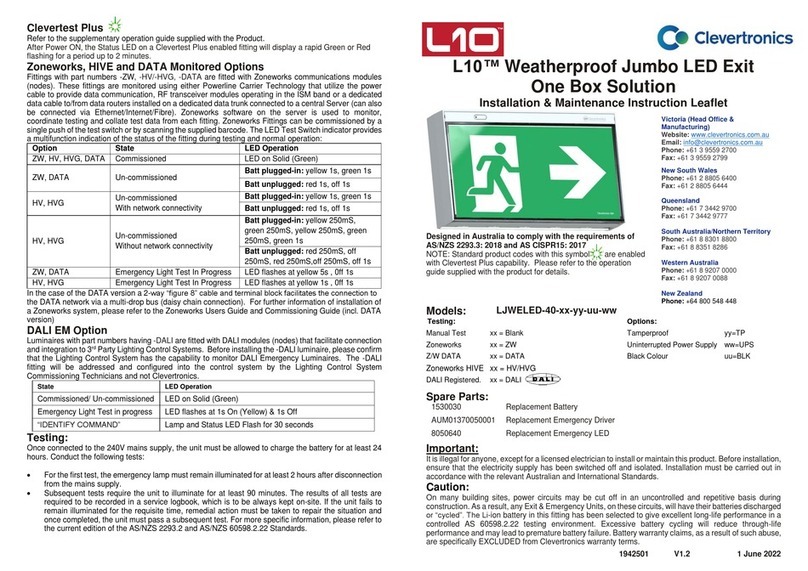
Clevertronics
Clevertronics L10 LJWELED-40 Series ASSEMBLY, INSTALLATION & MAINTENANCE INSTRUCTIONS
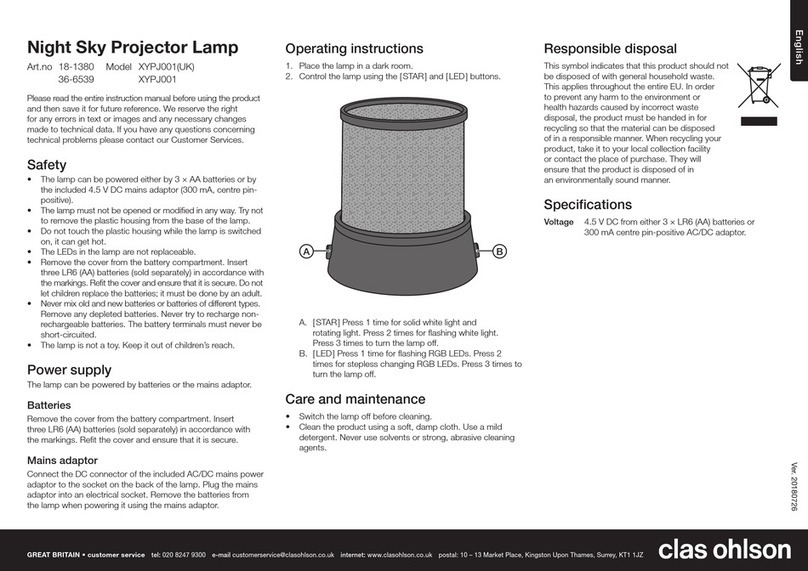
Clas Ohlson
Clas Ohlson XYPJ001UK operating instructions
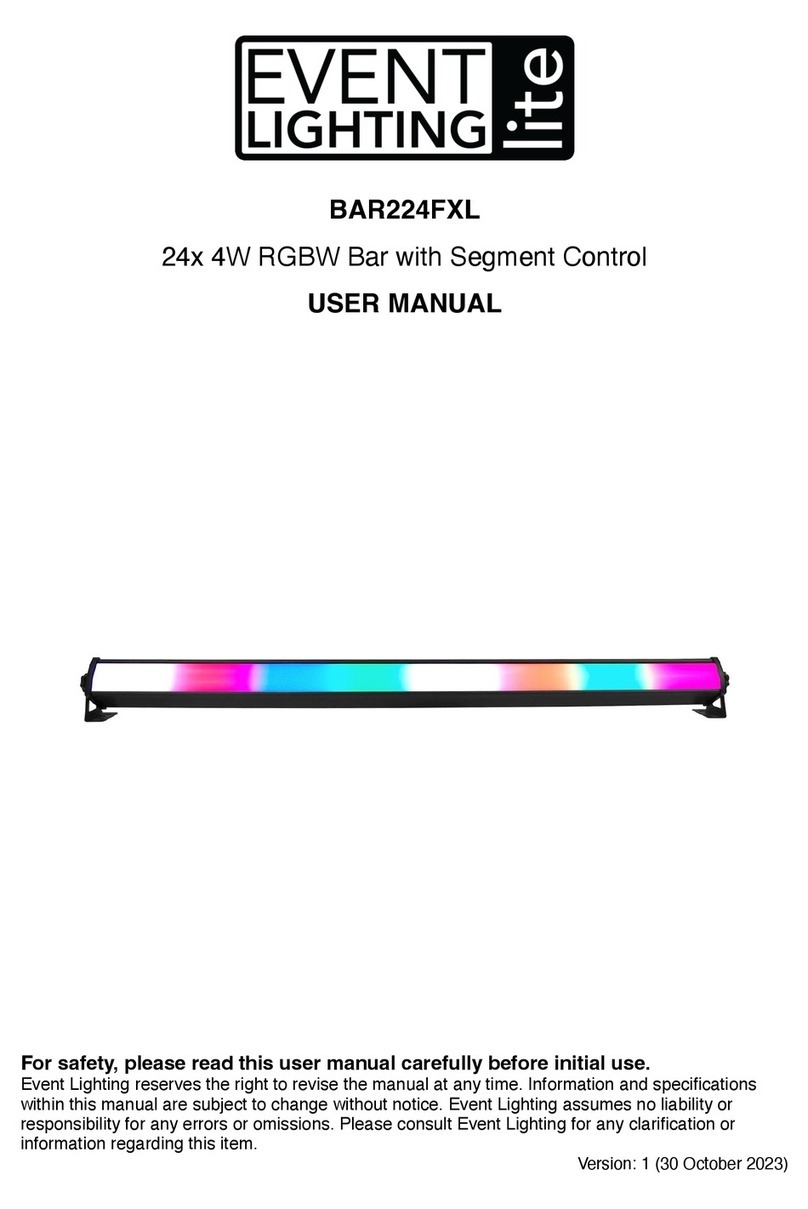
Event Lighting
Event Lighting lite BAR224FXL user manual
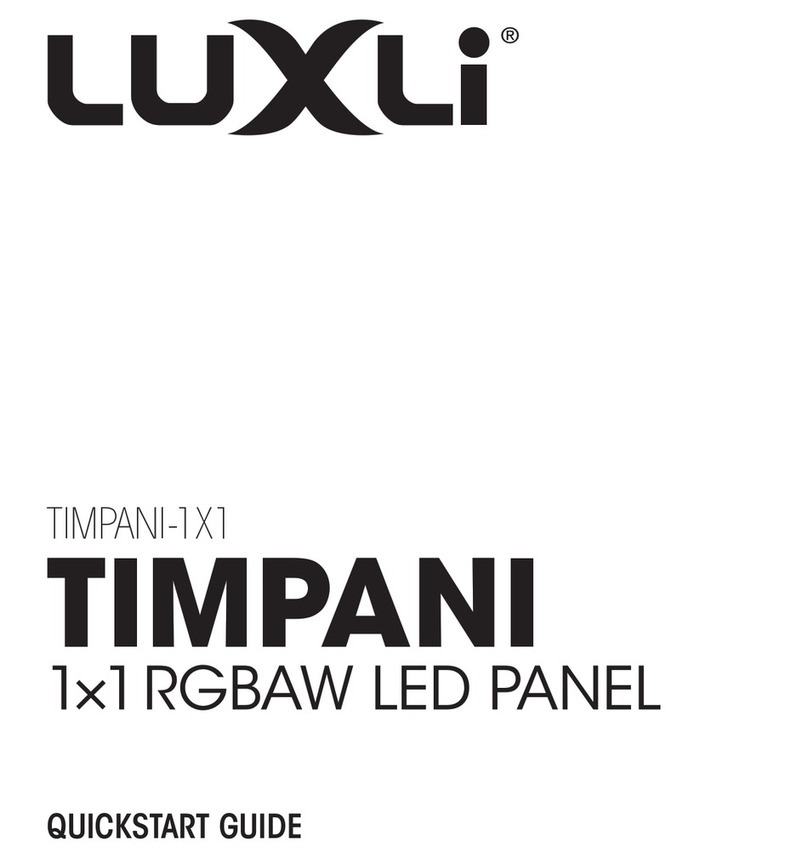
Luxli
Luxli Timpan-1x1 quick start guide
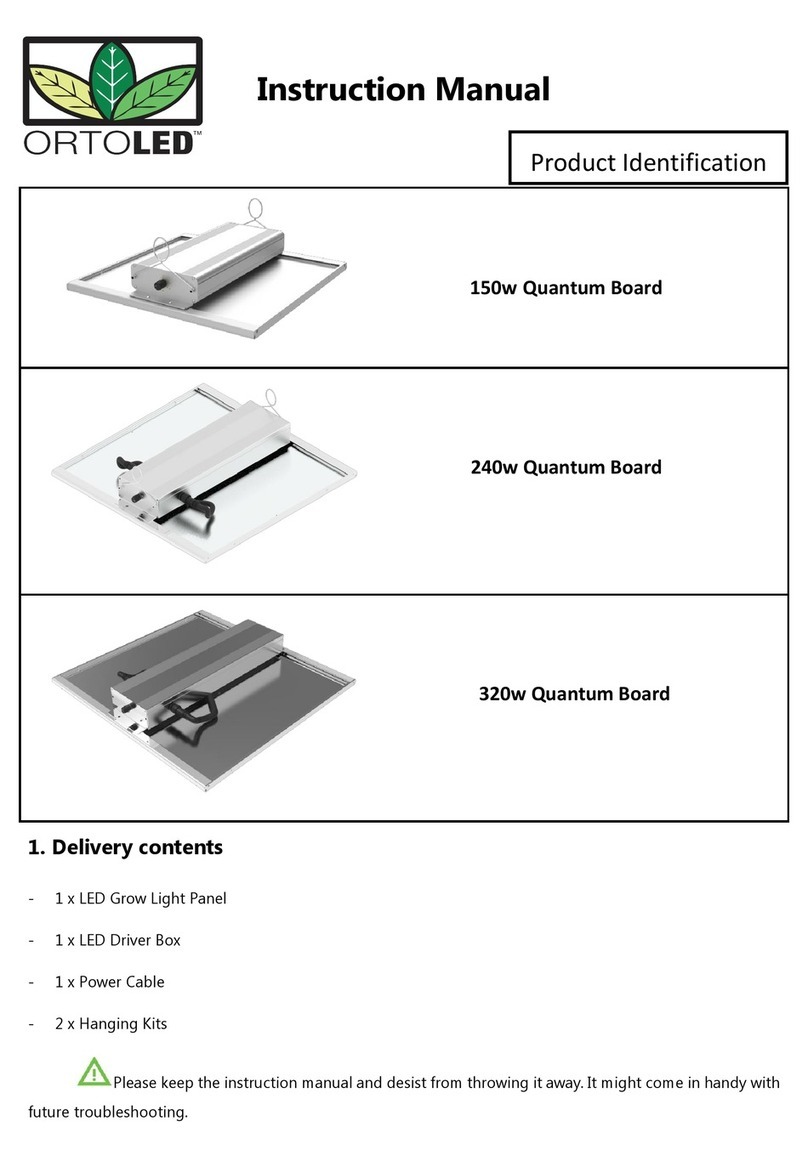
ORTOLED
ORTOLED QB-150W instruction manual
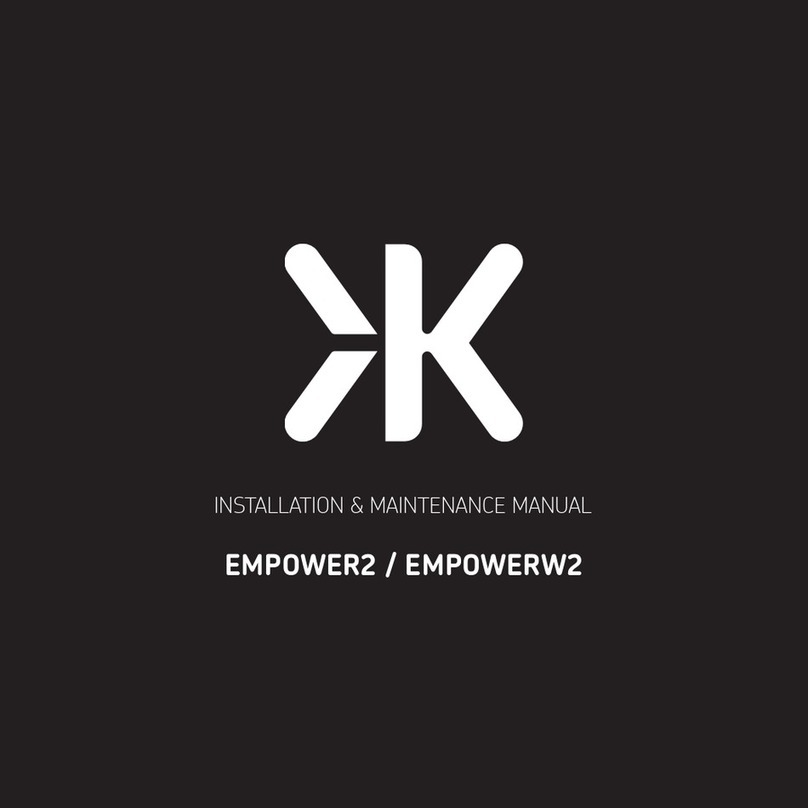
ML Accessories
ML Accessories EMPOWER2 Installation & maintenance manual

Rollei
Rollei LUMIS U-Light manual
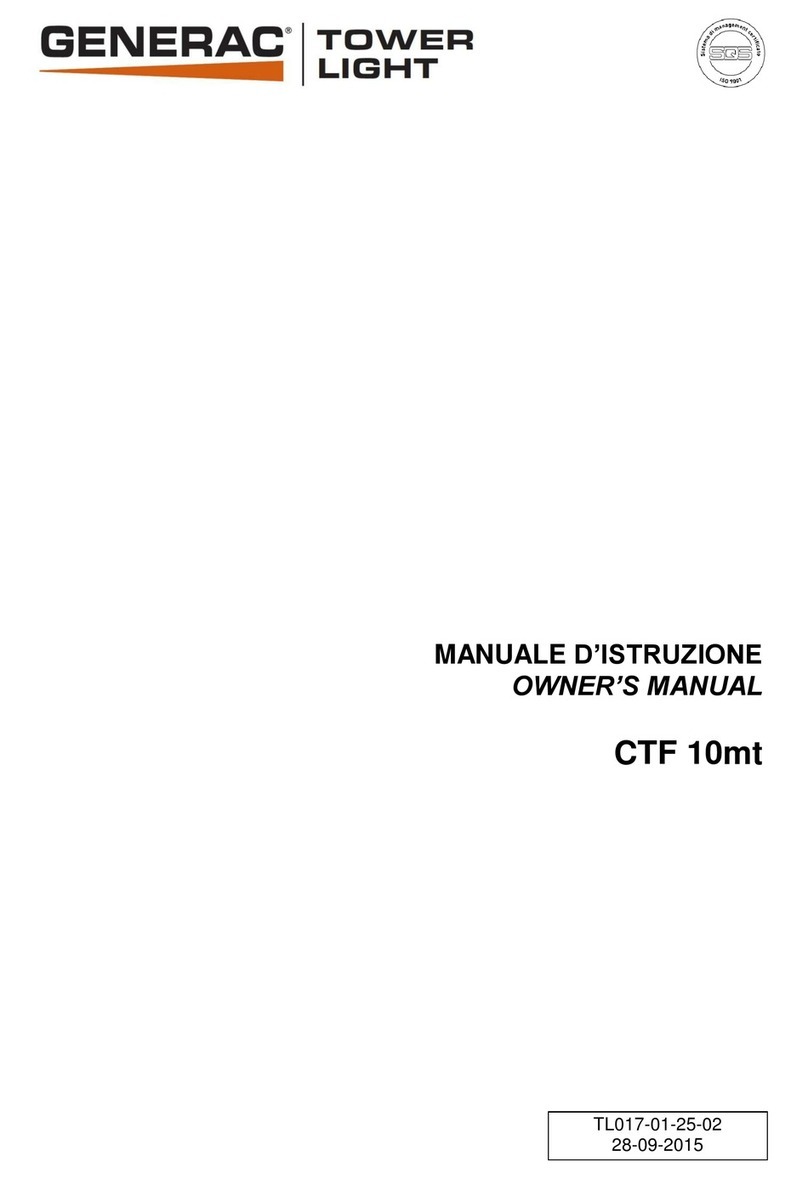
Generac Power Systems
Generac Power Systems CTF 10mt owner's manual
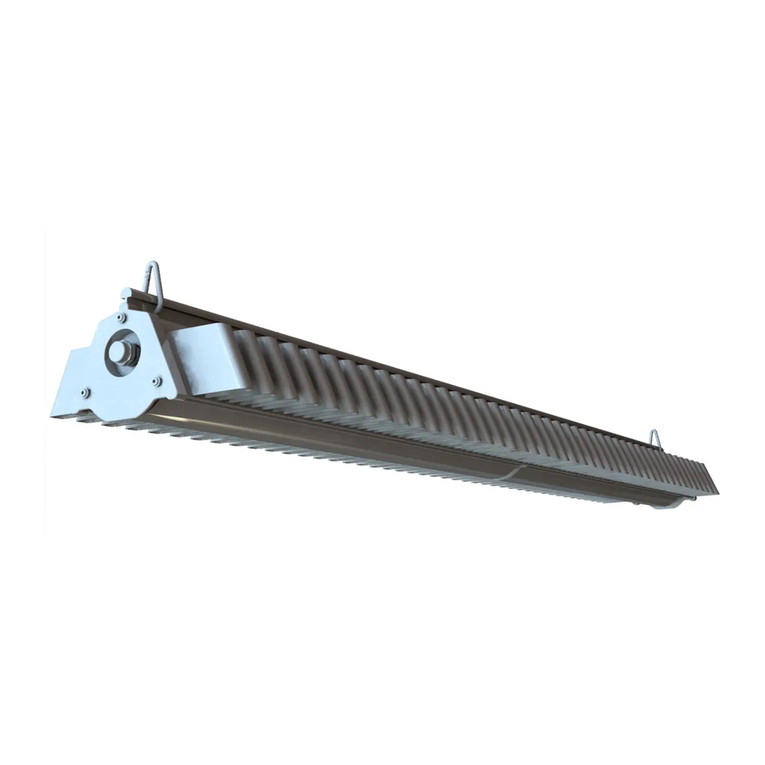
GE
GE Arize Element Series installation guide

Emos
Emos ZR2212 quick start guide

Heitronic
Heitronic 47211 Installation and operating instructions

Zumtobel
Zumtobel KXB S EVG ZONE2/22 BODY operating instructions
